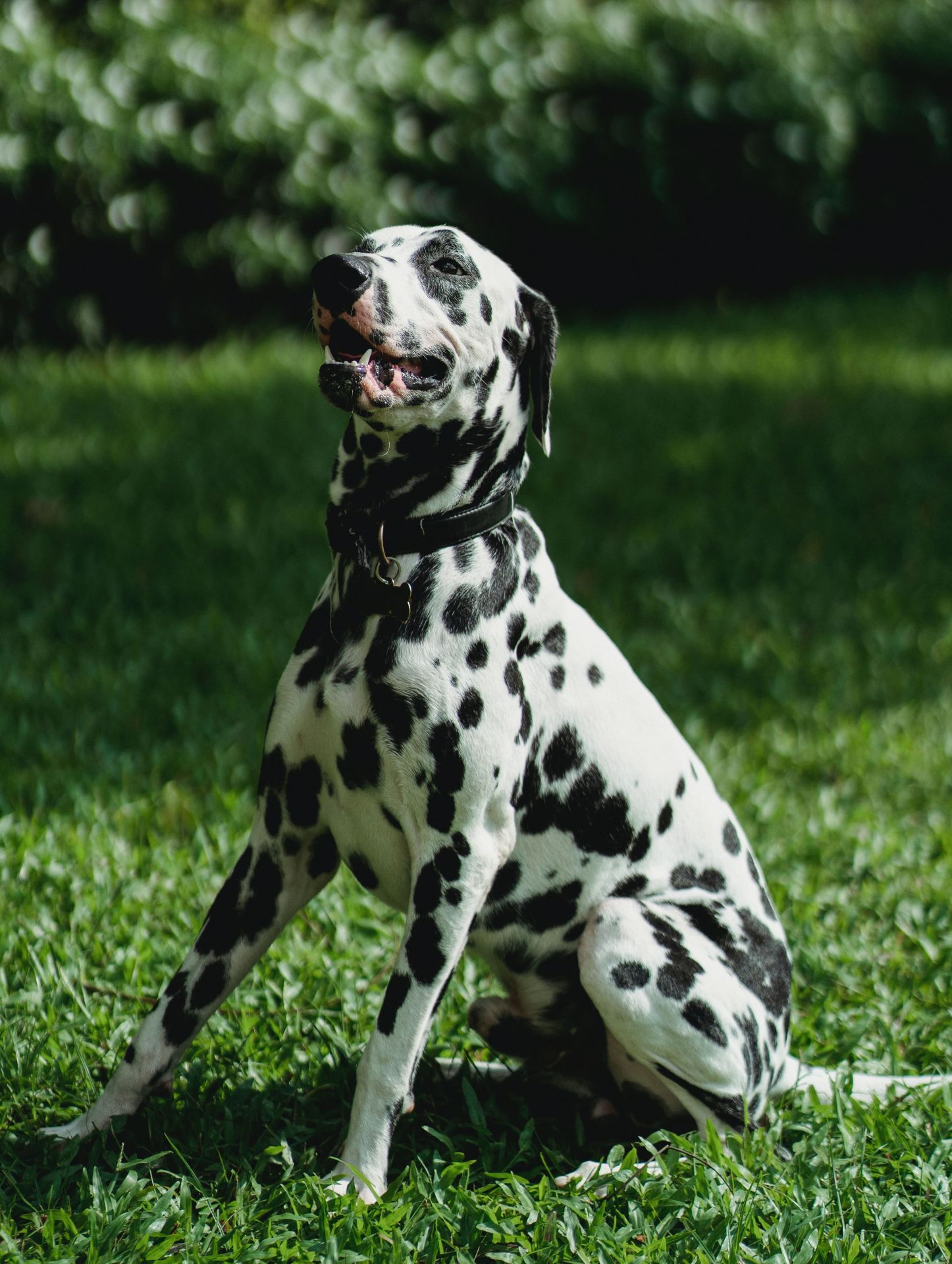Dalmatian

Most dog owners can’t get enough of the Dalmatian. This breed rose to Hollywood fame with the animated film 101 Dalmatians, but they’ve been charming dog lovers for hundreds of years. This unique breed is one of the most iconic dog breeds in the world. They consistently turn heads with their distinctive black and white spots and calm, distinguished demeanor.
This breed isn’t just about its looks. In real life, Dalmatians are renowned as firehouse dogs, hunters, and performers. They move with an effortless gait thanks to their well-balanced and athletic bodies. They were bred to be all-around protectors of horse-drawn carriages, but nowadays most Dalmatians are sweet, devoted family dogs.
Temperament
Most Dalmatians are outgoing and friendly dogs, being originally bred to work closely with humans and animals alike. They tend to be curious and intelligent animals, as the breed needed to be capable of independent problem-solving in order to excel at a wide range of tasks. However, because they were also intended to be guard dogs, they may be wary of strangers. They don’t tend to bite or be aggressive, but proper introductions must be made before they fully trust new people. A Dalmatian that has your trust, however, is very playful and gentle with both people and other animals. They can get along well with other dogs as well as cats, and their love for horses is one of their defining traits. Dalmatians are wonderful playmates for children when supervised. Because Dalmatians bond closely with their owners and family members, they dislike being alone and will want to be involved in most family activities.The Ultimate Guide to Dalmatian
Origins
The origins of the Dalmatian are shrouded in mystery. There is evidence that suggests that Romani nomads traveled with these spotted dogs, but it is difficult to credit anyone with creating them. The breed got its name from the region once known as Dalmatia, near the Adriatic Sea, in what is now Croatia. While the Dalmatian we know today surfaced in the 19th century, there are records of dogs with a similar appearance dating as far back as 3700 BC. The breed has been used as an all-purpose dog throughout their history – from herding dog and vermin hunter, to World War II messenger and circus performer. Dalmatians were brought to England, where they began to be used as coach dogs due to their affinity with horses. Dalmatians were even kenneled with the horses from puppyhood, strengthening the bond between horses and dogs. When firefighters started pulling their water pumps using horses, they realized the value of the Dalmatian as well. They needed dogs to clear the way for the horses at high speed, and the dogs would also keep the horses calm in the presence of big crowds of people, as well as fire and smoke. The Dalmatian was used by the Fire Department of New York City as early as the late 19th century. Even though the horses have been replaced by red fire engines, Dalmatians continue to have a special place in most fire departments, serving as mascots and companions.
Key Characteristics of Dalmatian
| Dalmatian | Most Dalmatians are outgoing and friendly dogs, being originally bred to work closely with humans and animals alike. They tend to be curious and intelligent animals, as the breed needed to be capable of independent problem-solving in order to excel at a wide range of tasks.
However, because they were also intended to be guard dogs, they may be wary of strangers. They don’t tend to bite or be aggressive, but proper introductions must be made before they fully trust new people.
A Dalmatian that has your trust, however, is very playful and gentle with both people and other animals. They can get along well with other dogs as well as cats, and their love for horses is one of their defining traits. Dalmatians are wonderful playmates for children when supervised.
Because Dalmatians bond closely with their owners and family members, they dislike being alone and will want to be involved in most family activities. |
| Exercise Needs | The Dalmatian had to have the stamina and athletic ability to keep up with horses, while also being able to watch out for threats and clear a path at the same time. As a result, they’re high-energy dogs and will want a good deal of exercise each day. They can seemingly run for ages, never stopping or slowing down.
Most Dalmatians will require an hour and a half to two hours of exercise each day. This can be split up into shorter walks or runs, with some time devoted to training and play. Dalmatian puppies require careful supervision before they can engage in really intense exercise, as their bones do not fully develop until they reach 2 years of age.
Aside from physical exercise, they also need a good deal of mental exercise. Puzzles and games will help keep your Dalmatian entertained and work their brain. Many Dalmatians also excel at various dog sports such as agility and obedience. They’re also powerful and agile enough for sports such as flyball, if you plan to compete. |
| Dalmatian Grooming | Grooming is one area where Dalmatian owners will have a very easy time. The Dalmatian has a short, dense coat of fur, which is easy to brush and maintain. Their coat does shed a moderate amount throughout the year, but regular brushing around once a week will help to minimize shedding.
Their coat is also surprisingly dirt and water repellent. Dalmatians have little to no doggy odor that usually accompanies other breeds. As a result, baths do not need to happen very often, with most Dalmatian owners settling on a schedule of once every three to four months.
Nail trimming can be done every two to four weeks. Brushing a Dalmatian’s teeth is also important to prevent tooth and gum disease, and should be done at least three to four times a week.
When bathing your Dalmatian, take care to clean and dry their floppy ears to prevent bacterial infections. During regular brushing sessions, take some time to inspect their ears for any swelling or irritation, as it may be a sign that their ears have not been cleaned properly. You may use a pet wipe or damp towel to clean their ears in between baths. |
| Dalmatian Training | There’s almost nothing that is beyond a Dalmatian’s abilities. They’ve fulfilled a variety of roles throughout the years, and this heritage shows in the breed’s trainability. Dalmatians tend to be agreeable and easy to train due to their high intelligence. That being said, they are known to be protective – they were meant to guard horses, after all – so obedience training will need to begin early before the dog develops bad habits.
Dalmatians are also known to be sensitive to how their owner treats them, so spare them the harsh language and punishments. They react much better to treats and toys as rewards, and this type of positive reinforcement will motivate your Dalmatian to follow commands much better than the alternative. |
| Dalmatian Lifespan And Health Issues | Dalmatians are generally healthy and live for 11 to 13 years. Dalmatians may be prone to:
|
| Dalmatian Size Snd Space Requirements | Dalmatians are a medium-size breed and are built athletically, but without excess bulk. Most adult Dalmatians will stand between 19 to 23 inches at the shoulder, and weigh between 45 to 70 pounds.
Houses with easy access to outdoor space are the best option for most Dalmatians, as owners will have to take them out for walks numerous times each day. Their extremely high energy levels and exercise needs may make them unsuitable for apartment living.
Dalmatians love spending time with humans and will want to live indoors with their family. They will need to participate in most family activities or they can end up being bored and moody. |
Other considerations:
- Dalmatians should have access to clean drinking water at all times, due to their tendency to develop urinary stones
- A Dalmatian’s spots don’t appear on their coats until they are about 3 to 4 weeks old.
- Dalmatians can have eyes that are brown, blue, or a combination of the two.
How can I take good care of my Dalmatian or Puppy?
Proper socialization
Dalmatian puppies are smart and agile, so it is important to socialize your Dalmatian puppy as soon as possible so that they grow up to be well-behaved and easygoing. While most puppies will be released to new owners at around 8 weeks old, it is possible to do socialization work in your own home while waiting for the puppy to complete their vaccinations.
Proper nutrition
Dalmatian puppies are high-energy dogs, so it’s important to get them high-quality, premium dog food. For specific amounts, consult your veterinarian so they can give a recommendation based on your dog’s health and expected adult weight. Due to their unique urinary system, they may need a low protein diet to keep from developing urinary stones.
Up-to-date vaccinations
Upon taking home your Dalmatian puppy, you should contact your veterinarian to get a vaccination schedule. Vaccination schedules will vary depending on the prevalence of common transmissible dog diseases in your area. Follow this schedule to the best of your ability so that your dog is protected.
Most Asked Dalmatian Questions
-
+How Much do Dalmatian Puppies Cost
